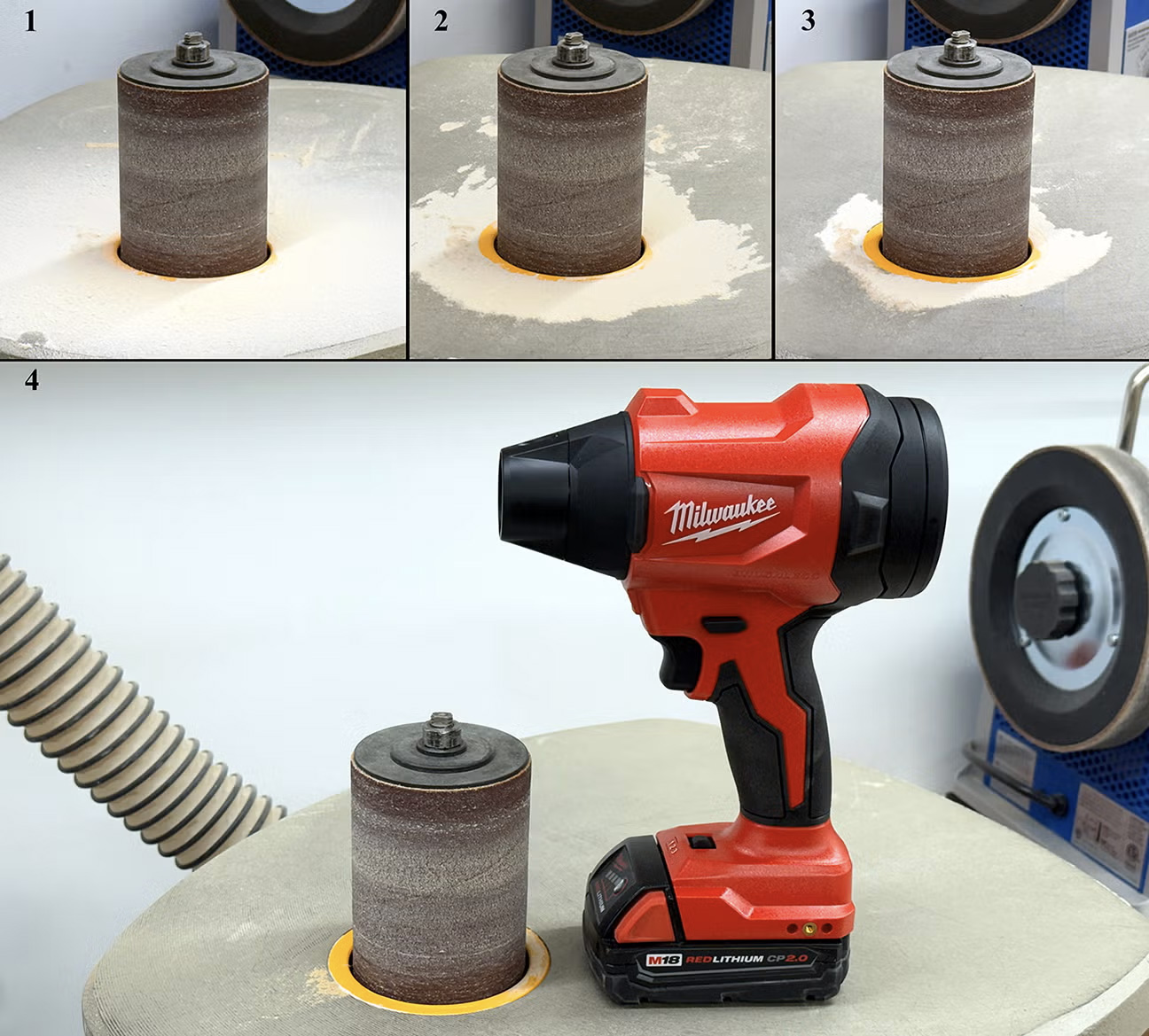We may receive a commission when you use our affiliate links. However, this does not impact our recommendations.
We’ve been testing the Veritas Quick-release Sliding Tail Vise for several months now and have been keeping as mum as possible. Now I can break my mum-ness and discuss this interesting piece of new bench hardware.
The idea is simple: Put a traditional European tail vise and a machinist’s quick-release vise into a tropical hotel with an ocean view. Open the mini bar. Order room service.
Their love child is this vise.
Like a machinist’s quick-release vise, it is easy to install , even to retrofit. We added this vise to the LVL Workbench in about a couple hours of work. We cut out the recess for the vise using a jigsaw and trued it up with a chisel plane. Then we bolted the hardware to the underside of the top and made the walnut chop.
Like a tail vise, it offers 100-percent support to wide panels when you are working on them and gets your row of dog holes right up in the front of the benchtop where you want them.
Like a machinist’s quick-release vise, you turn a lever and the the jaw slides open and closed with a satisfying swoosh.
Like a tail vise, you can lock the threads so that the jaw opens and closes with a screw-feed action. That means you can use this vise for assembly, disassembly and holding your work
Like a quick-release vise, it has guide bars to keep it from racking and it doesn’t sag.
But like a tail vise, there are no bars that get in the way of the vise’s functions.
To show you how this works, Megan Fitzpatrick and I prepared the short tour above. (And no, Megan doesn’t wear those sandals when she is working in the shop, so just shut your pie hole about that.)
Also, before you ask: The Acme-thread screw is indeed small, but the sucker is robust. You can really crank the thing down (not that you should ever need to). I think this vise is going to be a real game-changer when it comes to deciding which end vise to install on your bench.
The vise is available and in stock from Lee Valley Tools for $269 U.S.
– Christopher Schwarz
Other Tail Vise Links to Consider
– We’ll be testing out the tail vise hardware from Lie-Nielsen soon. I am told that it is “bombproof.”
– The Benchcrafted tail vise is an engineering marvel. And now the company has released an updated version that is easier to install.
– Be sure to visit workbenchdesign.net for all your workbench information cravings.
– And if you want a heavy dose of my off-centered view on workbenches, my book is a good place to start: “Workbenches: From Design & Theory to Construction & Use.”
Here are some supplies and tools we find essential in our everyday work around the shop. We may receive a commission from sales referred by our links; however, we have carefully selected these products for their usefulness and quality.











Hi,
I am wondering about how to maintain the benefit of a bench with a top
and legs in the same front vertical plane (i.e. no overhang, no apron), and still install this vise. Most of the installation information I see and examples posted on the net assume an overhanging bench.
Also, my bench is three inches thick. It seems to me that I ought to keep the front edge of the bench as is, only adding the extra material just at the end for the rear jaw of the vise to match the size of the moving jaw. But – a wild thought here – what about reversing the vise as if it will be mounted on the left end of the bench, and installing it upside down on the right inside, boxing it in under the bench to provide mounting surface. The object is to place the front plate higher, closer to the top of the bench. That way my bench front will be the same dimensions as the jaws
of the vise.
Rachel
Hi Chris,
Hope you are enjoying this exteme hot weather this fine Monday. Its a good day to be inside on the computer. I love A/C.
Anyways, I’m waiting for my wood to dry so I can start building my Roubo workbench. I have not decided yet what end vise to get. I’m thinking either the new Veritas Quick-release Sliding Tail Vise or the Benchcrafted tail vise. What do you think? Which one do you like better?
Thanks, Bart
Chris,
I have heard that traditional tail vises can some times sag after extensive use. Did you experience any sagging with this vice during your testing period? If not, do you think it could hold up to some moderate pressure or pounding on a piece of wood clamped in it?
Jason Wood
Rob,
<<1- Is the thickness of the chop variable or defined by the vise dimensions? What I’m thinking is that a thicker chop would give more depth to the vise for holding work to cut tenons, like a traditional tail vise.>>
You can make the chop thicker. There are going to be limits, but those would be easy to side-step with longer bolts.
<<2- It seems like quartersawn wood for the chop would be a better choice for seasonally consistent precision.>>
Sure – if you have it. If this chop casts I’ll true it up. If it gets irritating, I’ll replace it.
<<3- There are different-size holes on the vertical face of the chop. Is this Veritas’ suggestion?>>
Some of those are for bolts to attach the chop. Some of them connect with dog holes in the top of the chop so you can push the dogs up. That hole pattern is indeed the one supplied by Veritas.
<<4- Noting your description of the genesis of this tool, consider that you may be spending just a bit TOO much time in the shop.>>
Maybe I need some time in Vegas instead.
Nick,
Here is the troubleshooting guide from our web guy, Drew DePenning:
If you’re just seeing a black box, here’s a few things you can do.
First, install the latest version of the free Adobe Flash Player plugin from here:
http://get.adobe.com/flashplayer
After installing/upgrading, I recommend restarting your computer.
If you still see a black box, try right-clicking (control+click on a Mac) the box where the video should be and select "Settings". You should get a popup that says Adobe Flash Player Settings.
Along the bottom of this window, click the icon that looks like a folder. This tab should say "Local Storage" and display a slider. Drag the slider to the right to increase the storage space to 1 MB or more. Then refresh the page.
If this doesn’t work, please feel free to e-mail drew.depenning@fwmedia.com.
I’m still getting a black box where the vid ought to be. I have tried upping the size of the cache to no avail – currently set at 10MB.
I just have to marvel. When I started down this slippery slope close to ten years ago, there were so few quality tools or bench hardware available. Only a small handful of makers existed who really made top quality stuff. Now, there is a wide range of high-quality versions of all kinds of tools: common and innovative. And what’s even more amazing is the innovation going on in bench hardware. The fact that we will soon have multiple possible tail vises of interesting and valuable design is the real treat.
Thanks for bringing this all to us. It’s a great time to be doing woodworking.
Chris,
Looks cool. Few questions:
1- Is the thickness of the chop variable or defined by the vise dimensions? What I’m thinking is that a thicker chop would give more depth to the vise for holding work to cut tenons, like a traditional tail vise.
2- It seems like quartersawn wood for the chop would be a better choice for seasonally consistent precision.
3- There are different-size holes on the vertical face of the chop. Is this Veritas’ suggestion?
4- Noting your description of the genesis of this tool, consider that you may be spending just a bit TOO much time in the shop.
Ha,ha.
Rob
I see this hardware being adapted to a support a wagon vise retrofit sometime in the not-too-distant future. Set it in from the front edge of the bench, behind the right leg in terms of depth, and add a wood chop that has a bump up to the bench surface that moves in a long mortise. Hmmmm….
A nifty response to your revelations re: the virtues of using a QR face vise as a tail vise. (From the Holtzappfel bench.)
So when are they going to give you the dedicated 90 degree miter bar that you asked for on the table saw?